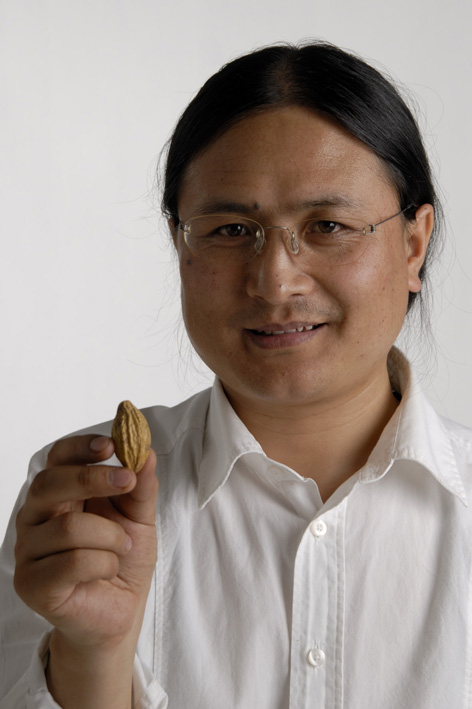
It’s been months since I’ve posted here, something quite regrettable. So to get back into the swing of things following my return to the U.S., I decided to whip up this quick translation of a long-distance interview that Dr Nida Chenagtsang, a Tibetan ngakpa or non-celibate tantric ritual specialist and Tibetan traditional doctor gave in Tibetan in 2014. Given its rich biographical and technical details, I thought that readers of this blog and students of Dr Nida would appreciate having access to an English language version.
The interview – conducted by astute interviewer Lu Nyön or ‘Crazy Snake Spirit’ – deals with Dr Nida’s two primary areas of expertise: Sowa Rigpa and Sang Ngak, that is, Tibetan Traditional Medicine and ‘Secret Mantra’ or Tibetan tantra. Lu Nyön and Nida la touch briefly on everything from Tibetan alchemical longevity practices, dream clairvoyance, traditional techniques of tantric sexual yoga, to contemporary near-death experiences with impressive clarity and directness. Dr Nida provides clarifications about the proper practice of advanced tantric yogas and gives useful introductions to both the Yuthok Nyingthik, the special esoteric Buddhist teachings aimed specifically at traditional doctors, and the Gyüshi, or ‘Four Tantras’ which together comprise the core exoteric textbook of Tibetan medicine.
Dr Nida also opens with a fairly extensive autobiography and resumé, which gives us rich insights into the teachers and experiences that have shaped him in his journey as a doctor and lama. I have done my best to convey in English the humility as well as frankness and wry self-deprecation which pepper Dr Nida’s account. While the first of these qualities is common enough to classic Tibetan prose, the other two are very much a symptom of Nida’s unique character. Nida’s writing is lively and clear, and he even spoils us with original ‘poetic interludes’ at various points in his narrative. As an anthropologist I love hearing stories and learning about people’s life-histories and I think they provide excellent opportunities to learn deeply about new and important things. With this intention in mind, I hope you will enjoy the following translated interview.
(For those who read Tibetan, the original interview can be found here: http://bod.sorig.net/?p=226)
********
[Interviewer: Lu nyön (‘Crazy Naga’)]
Q: Firstly, could you please give us an introduction about yourself and the process by which you became a menpa or Tibetan doctor?
A: An introduction to Dr Nida’s education –
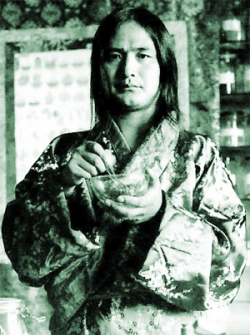
I’m Menpa or Dr Nida. People from Lhasa call me by the Mongolian word for doctor ‘amchi’, Khampas use ‘lhaje’, an archaic term, monks call me an ‘old ngakpa’ or tantric yogi. Some people call me a writer or poet and yet others call me ‘lama’ or ‘guru’. Some call me a Mongolian Bönpo. The well-known designation ‘menpa’ used by Amdowas is the name that I myself find most fitting and agreeable though.
Since education and experience are primary to any life history, the history I present here will mostly focus on my studies, which were I to describe them would go something as follows. I was born in the winter of 1971 in a yak fur nomad tent in Sogdzong or ‘Mongolian district’ in Mahlo county, Amdo. My Father is Jamyang Thupten from Amdo, Ngawa from the Chenag or ‘Black Tongue’ family paternal (‘bone’) lineage linked with the region, and my Mother is Drölkar of the Agé family. My Dad always said that our paternal lineage was of Tibetan stock and that my Mom’s maternal ‘blood’ lineage was Mongolian and I think the lamas of Ngawa have had some connection with the permanent holdings and territory of the Jaknag or ‘Black Tongue’ [hon.] family.
I went to school in one of the regional nomad tent-schools from a young age where even though I made a show of studying Tibetan writing and arithmetic, I only ever achieved extremely poor results. After that I enrolled in the Mahlo Sokdzong ethnic minority middle school, where although I studied many middle school textbooks on literary and colloquial Tibetan and Chinese, mathematics, geography, history, and other such things my grades were pretty inferior on account of my childhood propensity for distraction and laziness. Despite having lost all desire to go to school I was unable to find any cause to get myself expelled.
Between 1985 and 1989 I travelled to the Rebgong teachers’ training college. There I had to study about thirteen classes in language, chemistry, physics and so on. I made an inferior foundation in my education and experienced the most difficult four years of my life. Fortunately, the esteemed great teacher Tseshung Lhanyön Rölwa Tsal aka Akhu Lhamo Khyab was my Tibetan literature and poetry teacher. His nature was that of an unadulterated nomad and he was an expert instructor of poetry so I was really keen to attend his classes and I was thus able to develop a pretty decent foundation in Tibetan language. All the teachers and students greatly enjoyed poetry and composition then and some poems and articles that I wrote were also made use of in newspapers and other such places.
From Uncle Lhamo Tsang and Uncle Chögyal of Ditsha I also learned a little bit about ‘inner science’ or Buddhism. A teacher in ‘Chinese’ (modern/non-Tibetan/traditional) art taught me and a Chinese woman in particular how to draw/paint and I was able to achieve somewhat good results, but I later failed my drawing exam at university so a career in art was closed off for me. In any case, when I finished my studies, while my level two Tibetan and Chinese literature results were at least average, my mathematics and science grades hadn’t improved at all and so all I could perceive was that I had wasted a lot of time there, under compulsion, in school.
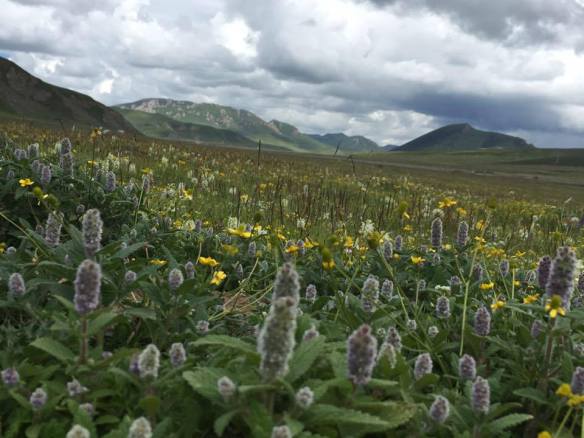
(Medicinal herbs growing wild in nomad pasturelands near Amdo, Mahlo, photograph courtesy Lucy Jones, 2016)
After returning to my home region I worked as a teacher at the Sokdzong ethnic minorities middle-school teaching world history, geography and Chinese but at that time, since I was young, having to do nothing but teach vexed me. I had maintained an interest in writing and when I thought about learning some other field of study, (it occurred to me that) both Dr Tsering Tashi and Dr Jigme from my home region were instructing many students in Sowa Rigpa or Tibetan Traditional Medicine and so, through the encouragement of a friend, I enrolled there. After studying the foundational texts for a few months, for about two weeks during mid-summer we went to the sunny edge of the great medicinal mountain called Dzomo or ‘Female Yak Hybrid’ to identify medicinal herbs. As far as learning about the basics of Tibetan medicine, natural environments of grassland and mountain, crag and cliff side, as well as pool and stream are able to exist there permanently side-by-side and so, for me, having grown up in the nomad grasslands, I really found this to be a most pleasurable undertaking. From then on a firm intention to study this kind of medicine to its fullest extent arose in me. And so, thanks to the kindness of Dr Jigme and particularly the esteemed professor Shingza Kalzang Chökyi Gyaltsan from 1990 I got the great opportunity to study both the foundational theory and practice of Tibetan medicine at the Mahlo hospital of Tibetan and Mongolian medicine.
It’s said: “Nomads herd sheep and farmers plant the fields – this is their unmistakable karmic allotment, so it’s wrong for the children of nomads to go to school” – however much you protest against this, you won’t be successful.
Shingza Rinpoche said to me often, “In the future you will write many things about Tibetan traditional medicine. If you’re able to translate contemporary medical science and Indian Aryuveda into Tibetan I think it will probably greatly benefit the development of Tibetan medicine. Study medicine vigorously with as little bias towards any medical system or philosophy as possible!” Later, he sent a letter to the great medical expert Jampa Trinlay and expressed his wish that I should be accepted by the University of Tibetan Traditional Medicine. Senior doctor Jampa Trinlay was keen and from 1991 until 1996 I studied the foundations of contemporary Sowa Rigpa, the Four Tantras or Treatises of Tibetan traditional medicine, the oral instruction commentaries of the medical forefathers connected with these, the Blue Beryl, and other such works at the Tibetan University of Tibetan Traditional Medicine [in Lhasa]. I learned about the Root Tantra and the Explanatory Tantra, which has as its basis the constituents of the body, the fundamental nature of diseases, and diet and nutrition. From esteemed Professor Karma Rigdzin I learned the science of both Indian and Chinese styles of astrology, and from Professor Gojo Wangdu I learned about the Pith Instruction Tantra, about pulse and urine analysis from the Subsequent Tantra, and in addition received reading transmissions and oral instructions from him for the Kongtrul Zintik and the Menche Dagyal and many other such texts. When it came to the practice of Tibetan medicine I learned the science of diagnosis and pharmacology, the great refining and purification of mercury, blood-letting, moxibustion, uncommon hereditary lineage practices of massage therapy, and many other practices from expert doctor Jamyang Lhundrup of the Lhasa Mentsikhang or Tibetan traditional medicine hospital and the Lhoka Mentsikhang in particular. They gave me all these without reservation, which was extremely kind of them.
Through question-and-answer sessions on both medical and tantric scriptures with Professor Gojo Wangdu I came to the definitive conclusion that a view supporting the integration of medicine and tantra was a greatly beneficial one. Specifically, from Tsultrim Gyaltsan and Troru Tsenam that pair of great non-sectarian adepts, I obtained multiple empowerments, reading transmissions and oral instructions relating to Tibetan medicine, the Yuthok Nyingthik (the treasure revelations of Yuthokpa), the Entrance into the Conduct (of a Bodhisattva, ie. the Bodhicharyavatara, the Ornament of Liberation, the Bright and Graduated Path (i.e. Lam rim teachings), The Lamp on the Path of Enlightenment (the Bodhipathapradipa by Atisha), the Entry into Knowledge (by Mipham Rinpoche), for the inner science of Buddhism in general and specifically dealing with both the New and Old School teachings of the Secret Mantra. They also instructed me in the essential points of Madhyamaka, Mahamudra, and Ati Yoga, for which I owe them a debt of gratitude impossible to repay. I requested multiple teachings from the Longchen Nyingthik dharma-cycle from the great yogini Ngawang Gyaltsen, the heart-disciple of Shugseb Rinpoche, the Venerable Lady Chönyi Zangmo, and after I had completed my ngöndro or preliminary practices and the approaching (i.e. visualization/recitation) practices of the Three Roots (Lama, Yidam, Khandroma), the great yogini gave to me Shabkar’s lineage of Mahamudra instructions and direct oral instructions on Trekchö or the ‘Cutting Through Hardness’ practices of Ati Yoga. She also gave me the pointing out instructions and prophecies for the Copper Coloured Mountain Pure-Land in a concealed manner.
After this, in Lhasa and at Lama Ling monastery in Kongpo I obtained the complete empowerments, reading transmissions, and oral instructions for the Dorje Phurpa (Vajrakilaya), Tröma Nagmo, Dorje Drolö, and the Heart-Drop from the Dudjom New Treasure system from that great quintessential definition of a ngakpa or holder of tantric practices Chönyi Rinpoche and Dudjom Rinpoche’s esteemed daughter Dechen Yudrön. I was also fortunate enough to thoroughly obtain practical instruction in the Creation, Completion, and Great Perfection stages, otherwise referred to as Maha, Anu, and Ati Yoga, as well as in particular, Dudjom Rinpoche’s ‘Purifying of Perception’ teachings on the emptiness-aspect ‘Cutting Through Hardness’ Trekchö practices and the ‘Ocean of Enjoyment’ pith oral instructions for the appearance-aspect ‘Leaping Over’ Thögal practices. In Lhasa I at least pretended to spend a little bit of time in retreat at the cave at Drak Yerpa, the cave at Chimpu at Samye, and at the Sheldrak or ‘Crystal Cliff’ cave in the Yarlung valley. In addition, I got many empowerments, reading transmissions, and oral instructions for the dharma-cycles of the Spoken and Treasure teachings, and practices of Phowa (consciousness transference), Chulen (alchemical elixir extraction), Tummo (inner heat), Bardo (After-death, in-between rebirth states), and darkness retreat yogas of the Nyingma school from several qualified lamas. With only the faintest understanding of these, I exerted myself to the extent of my own capacities however measly in Chulen and other such practices. With Sera monastery Geshe Gendun Sherap, originally from the Riwo monastery community, I took a stab at studying the monastic ritual manual of Sera, which was later extremely beneficial. Although these non-sectarian great sutric and tantric teachings at least laid down some positive mental imprints in me, all of them were extremely difficult to penetrate deeply and understand. After I finished the Yuthok Nyingthik preliminary practices and Yuthok Nyingthik Guru Yoga accumulation retreats I had some experiences that made things a little clearer and easier to understand. As such, the practice of the dharma-lineage of the Yuthok Nyingthik contains essential points of great blessing-power and I have come to recognize it as something karmically allotted to me and hold it as my most basic practice.
In general, when I stayed in Lhasa I had a great desire to study all and any medical and religious subjects and because my intellect was a bit sharper then I also began learning English and studied things like Tibetan history, art, crafts, geomancy and so on as much as I was able. In 1997 I studied the basics of modern (bio-)medicine and first aid at the Lhasa emergency medicine/first-aid hospital and did translations on this.
Those who presume to be ngakpa drink beer and have sex with women, only beer gets called a ‘tantric offering’ and ordinary women get called ‘spiritual consorts.’ Like a tiny stream that makes a giant sound, the so-called self shows its foolishness with arrogant words.
In the mid-summer of 1998 I went to Europe after being invited by the Shangshung Institute and during that time I also did work in the library and had the great opportunity to look at and read revealed Terma or ‘treasure’ teachings like the Longsel or ‘Tantra of the Clear/Luminous Expanse’ and revelations from masters like Nyakla Changchub Dorje, Lerab Lingpa and Ratna Lingpa, as well as various Bönpo cultural texts.
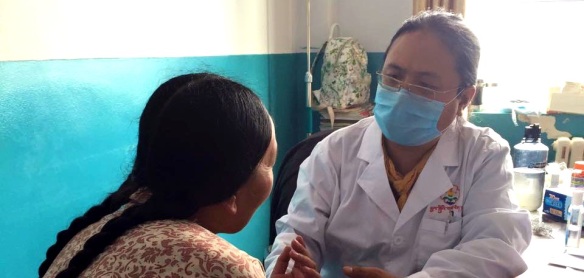
(Menpa Nida la consulting with a patient in Mahlo county hospital)
I began doing research on Tibetan traditional medicine giving instruction in Tibetan massage and mantra healing. I went to teach in several European countries and in Russia and Australia. I taught Tibetan medicine, massage, diagnosis and treatment, mantra healing, and geomancy and the like, and gradually my experience as a teacher became a little a richer. In 2006 I established the Sorig Khang International: Foundation for Traditional Tibetan Medicine. Today the Foundation has branches in more than twenty different countries. These branches in Europe, America, Africa, Asia, Australia and so on, are called ‘Sorig Khangs’ (for example, Sorig Khang Australia, Sorig Khang Estonia etc.) Today we have over thirty teachers and on average a couple hundred students each year. I am currently engaged in instructing foreign (non-Tibetan) students in the Four Medical Tantras of Sowa Rigpa, pharmacology, the taking of case histories, the Yuthok Nyingthik, the practice of Tibetan massage, the interdependent science of mantra healing, Tibetan medical psychology, the science of dreams, medical diagnosis and treatment and the like.
Likewise, I am also conducting authorized research into Tibetan pharmacology and treatments in countries abroad. Sorig Khang International has translated and is continuing to translate many different books on Tibetan traditional medicine into more than ten foreign languages. The Sorig Khang International journal, first published in the West, now comes out every year, and the international Sowa Rigpa Congress is now organized annually.
As for my publications, these include –
Tibetan language books: a book of poetry, Ngas khyed rang khu sum mer bzhag [‘I Leave You Quiet’]; a mixed Tibetan and Italian book, Zla ba ser po [‘Yellow Moon’]; books on medicine, Bod kyi bsku mnye’i lag deb [Manual of Tibetan Kumnye Massage], Nyi zla’i gso rig ched rtsom gces btus [‘Nida’s selected essays on Tibetan Medicine’], Bod kyi gso rig gi phyogs ston ‘khor lo [‘Compass of Tibetan Medicine’], and [Rten ‘brel] Sngags bcos rig pa [‘The Science of Interdependent Mantra Healing’].
Books translated into Tibetan: Myur skyob gso rig lag deb [‘Manual of Sorig First Aid’], which I translated into Tibetan from English and Chinese sources with along with another translator.
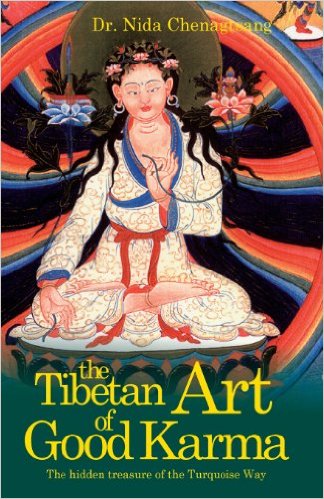
Books originally written in English: G.Yu thog snying thig gi sngon ‘gro’i ‘grel ba las bzang po’i sgyu rtsal [ literally ‘The Art of Good Karma: A Commentary on the Yuthok Nyingthik Preliminary Practices’], which was translated and published in about eight different languages, Bod kyi rmi lam gyi rnam bshad [literally, ‘Tibetan Dream Analysis/Explanation’], published in English, Italian and Spanish, G.Yu thog snying thig gi ngo sprod ‘ja’ lus gsang lam [literally, ‘The Secret Path to the Rainbow Body: An Introduction to the Yuthok Nyingthik’], Bod kyi sa dpyad [‘Tibetan Geomancy’], which was published in English and Spanish
Books in Italian: Bde thang gi gter [‘The Treasure of Wellness’], Bod sman gyi bsku mnye [‘Kumnye Massage in Tibetan Medicine’], Rmi lam rig pa [‘The Science of Dreams’], Sngon ‘gro’i ‘grel ba [‘A Commentary on the Preliminary Practices’].
Books in Russian: Ngos bzung brtag [‘Diagnosis/Identification’], Bod kyi sman sbyor [‘Tibetan Pharmacology’], Bsku mnye [‘Kumnye Massage’], Bod sman gyi nad khams rig pa [‘The Science of Pathology in Tibetan Medicine’],
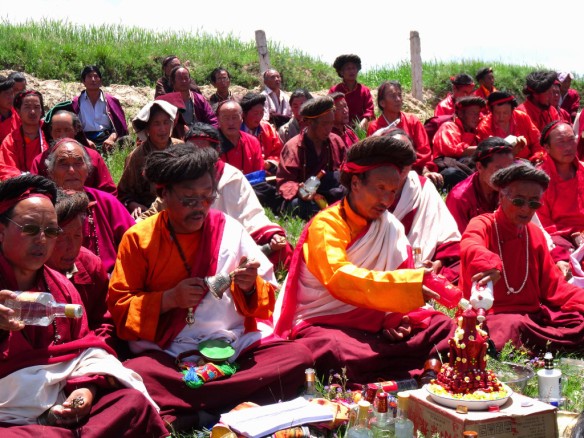
(The Rebgong Ngakmang, making ritual offerings)
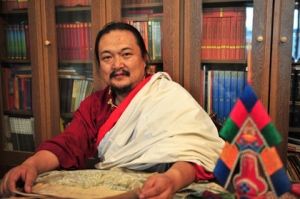
(Dr Nida’s older brother, ngakpa and scholar Hungchen)
These are the books already published, and there are others we plan to publish – both fall into one of two publication series categories: a series of course manuals on medicine and the Yuthok Nyingthik, and a series of publications for general circulation on these topics. In 2001 my elder brother who is in my home region and I established the Ngakmang (‘ngakpa/ma community’) Research Institute and in order to preserve the ancient texts of the Rebgong tantric community we have up until now entered more than fifty ancient texts into the computer and have so far published more than thirty of these. Each year I have also worked on a ‘Treatise on Desire’ or Karma Sutra that deals with the topic of desire on three connected levels and that focuses on: the preservation of the education of ngakpa and ngakma; public health education for lay men and women; and in particular, prevention of sexually infectious diseases.
As for further undertakings to support students and education, this is ongoing work we bear on our shoulders, and so requires no special mention. Thank you.
The goal is not to gain the praise of any other,
It’s not about chasing after money and riches
May this priceless and supreme field of study, eternally
Ensure the spread of Buddhist teachings, wealth and happiness to all!
Q: Is there some direct connection between what our dreams are about and our bodily and mental health?
A: Mental disease has been very strongly analysed through dreams in Western medical systems, and there’s a great deal of truth in this. However, there is no analysing of the three humours and especially not bodily sickness through dreams in Western medicine. The same goes for Chinese and Indian medicine, but since these utterly lack the precision of all the kinds of (dream-based) explanations found in the core texts of Tibetan medicine and the system of the Secret Mantra, the traditional Tibetan science of dreams is clearly something really unusual and amazing. According to Tibetan medicine, not only can dreams reveal any sort of mental sickness, disturbance of the humours and bodily disease but it is also taught that dreams are extremely useful in allowing doctors to predict whether a patient will live or die.
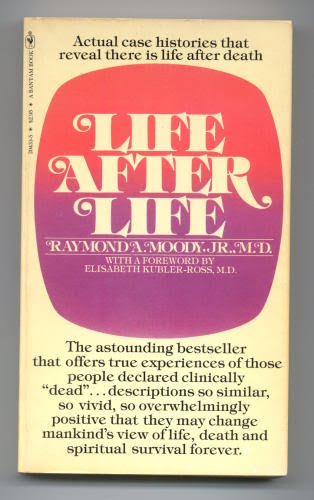
(Dr Raymond A. Moody, J.r.’s classic book on Near Death Experiences, first published 1975)
Q: Has research ever been done on signs of impending death shown in dreams, on things like the ‘Self-Liberation of the Signs and Omens of Death’ which is in line with the Bardo Thödröl or ‘Liberation by Hearing in the Intermediary State’ teachings of the Secret Mantra or tantric tradition? Do you think that only sick people who are themselves close to death can know about this sort of thing?
A: Since dreams that are omens of death come before one dies, they are said to be inexact omens. They come one year, one month, one week or even one or two days before death. If one experiences death-omen dreams without being sick or injured it represents obstacles. These days, in hospitals there are many stories of delog (‘those who have gone beyond and returned’, i.e. people who’ve had Near Death Experiences), and some of their descriptions of the stages of the signs or omens of death have been for the most part in accord with the Bardo Thödröl. I have checked and discussed these things.
Q: I had some results from practicing the ritual for accomplishing dream-clairvoyance from Mipham’s grimoire, but why is it that whatever is revealed to me is only ever some kind of depressing or distressing affair, and never anything happy?
A: Dream-accomplishment is a practice that reveals both auspicious and inauspicious things and so one has both good and bad dreams. However, according to Western dream systems/psychology, when one’s own mind fears bad things and thinks predominantly about them, this is the kind of thing that will for the most part come about in dreams. Things like the date, timing and sleeping method used in one’s dreaming practice also make a difference.
Q: Once a person has mastered the three-fold practice of 1) ‘catching’ one’s dreams (i.e. recognizing them and becoming lucid), 2) transforming their contents, and 3) proliferating them, having seized the dream in this way that person can clearly perceive themself travelling to other realms, can clearly perceive some or other different person’s activities and circumstances, and so on.
In such a context, is the gross consciousness or awareness of that person’s mind located within the gross bodily form of that person, or has it travelled with some kind of subtle consciousness, some subtle mind-body to a different location?
A: The foundation of Dream Yoga is ‘catching’ or ‘holding’ the dream. From there, purifying or ‘training’ your dreams and proliferating and transforming their contents, as well as travelling to Buddha lands or dimensions and so on, is something that one needs to gradually train in. Up until now, I myself have achieve a somewhat stable foundation in seizing the dream. Making oneself travel to other realms or spiritual dimensions involves the subtle winds and mind. The gross winds and mind are inseparable from the body whereas their subtle counterparts are things that can project inwardly or outwardly anywhere at all. In line with the Guhyasamaja, the extremely subtle winds and mind are the basis of the illusory body and it is taught that those who have gained experience in practices involving it will be able to manifest in the Sambhogakhaya body when in the Bardo, or intermediary after-death state.
Thus, it is quite easy to understand the differences between the gross winds and mind, and the subtle and extremely subtle winds and mind. For the practices of the Completion Stage Six Yogas one needs the foundation of the ‘Vajra Body’. I was able to request and obtain direct instruction about this from esteemed Master Tsenam.
Q: If a person practices Tummo or Inner Heat Yoga just from having read books and without having received the dharma-lineage will they still be able to make heat blaze in their bodies?
A: Given that Tummo is part of Highest Yoga Tantra Secret Mantra practices one really needs empowerment, reading transmission, and in particular, good, thorough oral instruction for practice. As such, you can’t just do the Trulkhor or ‘magical wheel’ physical practices of Tummo randomly. Tummo has outer, inner, and secret aspects: the heat of outer Tummo can be achieved through recourse to special substances, and in this just physical exercise or use of Vase Breath can help for the most part. However, when the blissful heat of inner and secret Tummo blazes this comes from experiencing the incineration of the afflictive emotions and conceptual thought (which gives way) to the Great Bliss of Primordial Wisdom or Gnosis. Disconnected from the practice of Guru Yoga there is no way this can happen. Today, some so-called Tibetan reincarnate lamas are teaching Tummo as mere bodily exercise without transmitting the instruction-lineage, which I think is a blight that harms the teachings of Buddhism.
Q: What kind of meditation practice is the ‘Great Vase Breath’ (Bumbachen in Tibetan)? Is it or is it not a breathing or subtle-wind related meditation method common to both Hindus and Buddhists?
A: There are a few kinds of Bumbachen breathing meditations but the most common is the one that has four ‘unifications’ or breathing stages. It originally became known through Mahasiddha Saraha’s lineage, but there are a variety of distinct meditation methods according to one’s practice. For example, there are various alternative Bumbachens in the context of demonstrating the body locks, and additionally there are slightly different Vase Breath styles for each of the explanations for the three levels of practitioner – greater, average, and lesser.
My lineage is contained within that of the yogini Ngawang Gyaltsanma, the direct disciple of Shugseb Rinpoche, the Venerable Lady Chönyi Zangmo, which is also a part of the Lord of Refuge Shabkar’s family lineage. Due to the fact that my supreme lama was very good at Tsa Lung (or ‘channels-winds’ tantric yogic practice) and the practice of Tummo, it is said that previously, when she was freezing in a Chinese prison, even though she was confined to a cell she melted the ice. However, this practice was spread much more in the Tibetan Secret Mantra tantric tradition than the Hindu religion. The nine-fold purifying ‘stale winds’ breathing meditation was something that was propagated in both the Tibetan and Hindu traditions, and even the though the practices of some Tibetan systems or schools are not equivalent, the basic points and inner significance of these practices are the same.
Q: In one version of the practice of the ‘Four Blisses’ we have the approach in which the man releases his ‘bodhicitta’ or semen into the woman’s ‘bhaga’ or vagina. In Je Tsongkhapa’s prayer on the Guhyasamaja Tantra he states that, “By uniting the Sky-Expanse with the Vajra, the bodhicitta melted by the blazing heat of candali comes through the Avadhuti channel and reaches the anther of the Lotus of Wisdom.”
Then, in another system, it is taught that when one practices the Four Blisses one should never release one’s bodhicitta. In light of this, is this some special distinction of the various tantric classes and deity practices?
A: There are several kinds of Karmamudra (physical consort) or ‘Lower Gates’ practice. The main meditation style involves four blisses of the channels but there is also one with around eight blisses or alternatively sixteen. There is also the slight disparity between the New Translation schools with their classification of ‘Highest Yoga Tantra’ and the Nyingma Old Translation school’s ‘Anu Yoga’ classification. Nonetheless, the essential meaning of the integration of Bliss and Emptiness is the same. Moreover, in the context of the descending, holding, reversing, and spreading out movements which comprise the pulling up and reversing of the sexual energy drops there are practices in which one only pulls up the white drop and practices where one pulls up the white and red drops together. With the latter, one first ejaculates one’s semen into the bhaga and then pulls it up again along with the red essence vaginal secretions and spreads this out. There is also another practice where the release of semen is permitted called the ‘Five Times/Seasons’ used particularly in the context of the enhancement practices for which one absolutely needs an experienced lama who possesses the direct oral instructions. The Rebgong ngakpa community also has a Lower Gates practice that combines Anu and Ati Yoga systems.
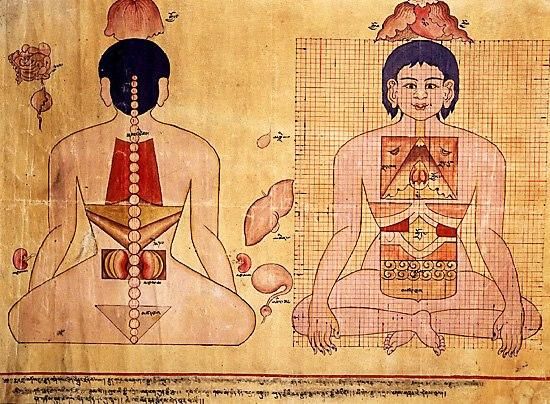
Q: In earlier times, Tibetan experts at the Mentsikhang in Lhasa carved the text Lüthig Dawa Norbu (‘The Moon Jewel of Body Measurements’) onto wood-blocks, and there was a custom in place where once doctors and students drew out lines and proportions as taught in the Dawa Norbu under the careful supervision of lama and doctor Khyenrab Norbu, they would have to write an exam on the nerves, muscles, and bones and so on. Is there anything like this today?
A: The practice of ‘jang khok yul thig’ (or of drawing lines that correspond to the inside of the body and its important contents) is widespread and a book of anatomy for the Tibetan medical system has already been prepared by Sorig Khang so I invite readers to take a look at that. What’s called ‘lü thig’ (bodily lines or proportions) and ‘tsa thig’ (channel lines) are known as jang khok yul thig in the medical tradition. In esteemed medical teacher Samten’s ‘New Dawn of Sowa Rigpa’ and great doctor and expert Gojo Wangdu’s ‘Mind Ornament of Yuthok’ and so on, there are collected illustrations of the muscles, bones and so on, which are in line with contemporary anatomy, but we really need to continue having profound discussions and engaging in deep research on this with Western bio-medical doctors. We really need to supplement commentaries on anatomy from Tibetan traditional medicine. The Four Tantras and commentaries are not at all sufficient by themselves. I hope that there will be more people who will conduct specialized research on this in the future.
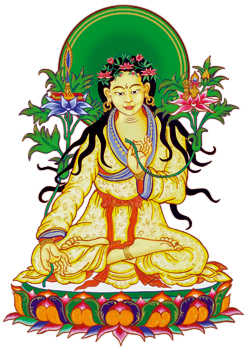
(The King of Doctors and Medicine, Yuthok Yonten Gonpo the Younger)
Q: Could you please give an introduction to the Yuthok Nyingthik?
A: The Yuthok Nyingthik or ‘Heart-drop of Yuthok’ is the secret heart precious and special teaching of the King of Doctors, Yuthok Yonten Gonpo the younger (1126-1202). There are two most primary teachings or heart-jewels of Yuthok the Great, these are said to be the Four Medical Tantras of Sowa Rigpa of relative truth or conventional reality for common disciples and the Yuthok Nyingthik of ultimate truth or absolute reality for uncommon disciples. Of these, the Four Tantras are Sowa Rigpa, the Science of Healing of the system of the rishis or sages. This is a science of medicine that keeps oneself and others well when not sick and that heals them when ill without looking down upon or discriminating against anyone by virtue of their religious, race or ethnicity, or status, and that also teaches how to bring about the religious insights, wealth and happiness desired by common disciples.
The Yuthok Nyingthik is a complete Vajrayana tradition that has been taught for the sake of individuals with special qualities who are striving for liberation and which allows for the attainment in one human lifetime and body of the ultimate goal of Buddhahood or the Rainbow Body of the Greater Transference. Given that the Yuthok Nyingthik is a special and precious teaching that was bestowed upon Yuthok the Younger by the Dakini Palden Trengwa in a pure-perception vision it is none other than the mind-treasure of Yuthok, the blessing of the un-dissipated breath of the Wisdom Dakini. ‘Heart-drop’ is a technical religious term from Dzogchen or the Great Perfection: ‘The energy-drop of the heart-mind’ refers to the ultimate dharma or reality of the mind and is akin to Longchen Rabyam’s Nyingthik Yabshi, Awareness-Holder Jigme Lingpa’s Longchen Nyingthik and Karma Rangjung Dorje’s Karma Nyingthik.
The Yuthok Nyingthik’s extended name is the ‘Heart-drop of Yuthok, the Dharma-cycle of the Blessing of the Guru Yoga Sadhana that is the Sunlight of Compassion that Dispels the Darkness of Suffering.’ The root scripture was actually written down as notes from Yuthok’s direct instructions by Sumtön Yeshe Zung and supplementary teachings and amendments were then later made by masters like Zurkharwa Nyamnyi Dorje, the Great Fifth Dalai Lama, Kongtrul Yonten Gyamtso and Chökyi Senge.
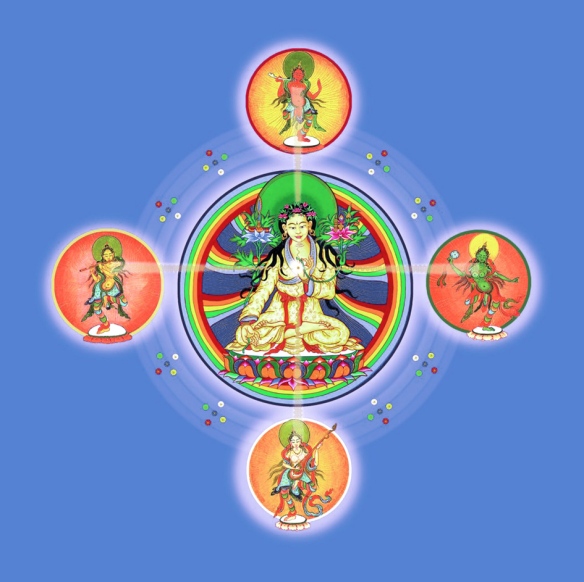
1) Preliminary practices – these are for inducing confidence in preparing or setting up the foundation for the path of the Secret Mantra. Here it’s possible to divide these into three: common, uncommon, and routine preliminaries. For an extended treatment see the introduction to the preliminary practices of the Yuthok Nyingthik which I have written.
2) Concerning the Creation Stage, there’s the outer, inner, secret and condensed guru sadhanas and daily practices of Yuthok which unify the Creation and Completion stages and purify or transmute ordinary or vulgar appearances into primordial wisdom. The auxiliary practices include the Dakini sadhanas, the Dharma Protector sadhanas, longevity sadhanas, the rituals for eliminating spirit-obstacles that disturb the equilibrium of the body, medicine sadhanas, rituals for acquiring root divinatory familiar spirits, rites for pressing down unruly demonic spirits, and the fire-offering rites of the four magical tantric actions.
3) Concerning the Completion Stage, there’s the Completion Stage practices of the ‘Spontaneous Dawning of the Three Bodies’, which are instructions on the channels, winds, and drops in which the body, speech, and mind appear respectively as deity, mantra, and primordial wisdom. There are instructions on the ‘Magical Wheel’ exercises of channel-and-winds practices, as well as yogas of the Path of Great Bliss of the Lower Gates, Inner Heat, Dream, Clear Light (Sleep), Illusory Body, Transference, of transferring one’s consciousness into another body after death (Trongjuk), and the Bardo or Intermediary State.
4) Concerning the Great Perfection, the ‘The Great Self-Liberation of Samsara-Nirvana’ is taught, which is the Great Ati Yoga instruction on Trekchö or the Primordial Purity Cutting Through Hardness which points out all phenomena of perceiver and perceived into the expanse of awareness.
The special, uncommon characteristics of the Yuthok Nyingthik are that it is extremely easy to accomplish and that signs and results emerge perceptibly in even one week of practice. It has few components or sections of teachings and is convenient to implement. It contains every teaching of the Vajrayana fully in a single text.
Seeing that the Yuthok Nyingthik has no sectarian bias many great lamas of all the schools, Nyingma, Kagyu, Sakya, Geluk have put it into practice throughout history and the medicine sadhanas of the Yuthok Nyingthik have spread throughout several different monastic communities. If one is a qualified Tibetan doctor, practicing the profound teachings in accordance with the Yuthok Nyingthik is indispensable and so young doctors today should think carefully about this and exert themselves in these ultimate ‘pure meaning’ teachings.
The great secret vajra path of the Rainbow Body
The ultimate ‘pure meaning’ teaching of the Self-Liberation of Samsara-Nirvana
May this teaching of the Heart-drop of Yuthok
Spread throughout all the world!
(Composed by Nida Chenagtsang in the Italian capitol Roma in February, 2010)
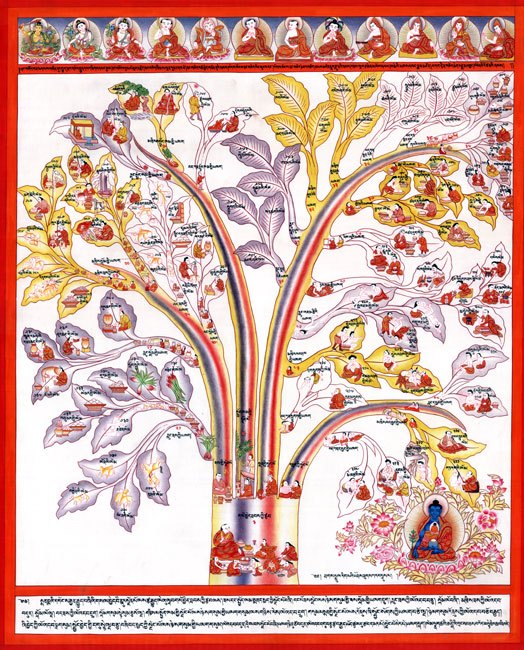
(Tree-like diagrams and systems in the teaching of Tibetan medicine)
Q: Could you please provide an introduction to the Four Tantras of Sowa Rigpa?
A: The Four Tantras of Sowa Rigpa are the most famous medical texts in Tibetan medical history. They were composed by the King of Doctors Yuthok Yonten Gonpo (the Elder) in the eight century and re-edited by Yuthok the Younger in the twelfth century. Sumton Yeshe Zung first copied and block-printed the text and also first began writing commentaries. Over more than 800 years many expert commentaries of the Tantras appeared. The Four Tantras of Sowa Rigpa are the basis for all of the practices and original sources for the entirety of Tibetan medical culture, and so it has become nothing short of an indispensable foundation for an education in Tibetan medicine.
The Four Tantras of Sowa Rigpa comprise:
* The Root Tantra: The introduction to the root-tantra of Tibetan medicine completely introduces the Four Tantras and the reality of their having the five perfections (i.e. they constitute a perfect teaching, from a perfect teacher, at the perfect time, place, and with the perfect retinue of disciples). The Root Tantra clearly lays out a summary of all these: the basic nature of disease according to an uncommon tree trunk-like model, the identification and diagnosis of diseases, and methods for curing them.
* The Explanatory Tantra: This contains the more essential aspects of traditional knowledge truly needed for the study of medicine. It teaches about the production, maintenance, and destruction of elements and constituents in the human body and how sickness enters the body in that regard, expert methods or technologies for remedying disease, about diet, lifestyle, and medical treatment, about ways to protect healthy people from disease (i.e. preventative medicine), methods of diagnosis, the basics of curing, and doctors’ ethics.
* The Pith Instructions Tantra: this deals with the science of the elements of disease. It teaches in fine and extensive detail about diseases of the three humours, about the causes and conditions (etiology) of bodily and mental diseases, about symptomology, and cures and preventative measures related to the fourfold antidotes.
* The Subsequent Tantra: This teaches the primary explanations on practice, methods of pulse and urine analysis, formulas for pacifying diseases, purifying functions and the science of treatment and cure.
The first foreign language into which the Four Tantras were translated was Mongolian. They were then translated into Russian and also Chinese and published in these languages. The Indian Ayurvedic doctor Bhagwan Dhash translated most of the Four Tantras into Sanskrit and English and recently the Root Tantra and Explanatory Tantra have also both been translated together into English. Some of the Sorig Khangs are also currently in the process of translating the Four Tantras into roughly ten other languages. Because the authentic spread and development of Sowa Rigpa or Tibetan traditional medicine depends on the Four Tantras, just obtaining, promoting or translating the Tantras is not enough – what we really need is new commentaries that fit with truly contemporary environmental, climate, diet and lifestyle, psychological, scientific and legal realities and concerns. Research that is relevant for our times is indispensable for the future development of Sowa Rigpa.

Pingback: Una semana de ocultismo en letras, imágenes y sonido, 27.2.17 – Mi escalera hacia El Todo
Pingback: Yuthok + Sowa Rigpa: Intro to Tibetan Healing with Dr Nida Chenagtsang - Menla
Pingback: The White-Robed, Dreadlocked Community: Dr Nida Chenagtsang’s Introduction to and Defense of the Ngakpa Tradition | A Perfumed Skull
Pingback: Two new upcoming courses with Dr Nida Chenagtsang: Sorig Foundations II & Yuthok’s Heart Teachings | A Perfumed Skull
Pingback: Dr. Nida Interview – Buddhist Social